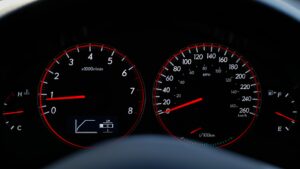Operator Condition and State of Mind
A good defensive driver is a driver who is always in the proper frame of mind and in good health. Never drive if you are ill or angry. If you do not feel well, your mind may focus more on your ailment than on the road. If you are dizzy, your vision and ability to judge distances may be hampered. If you are depressed or angry, you’ll face the same challenges.
Your complete focus may not be on the road but on the source of your anger or sadness. When angry, you may overreact to another driver’s careless behavior. Later in the course, you will read about road rage.

Whether ill, angry, sad, or depressed, your decision making skills and good judgment will not be at their best. Know when you should not be driving. Delay your trip or find someone who can drive for you. By the way, never assume that taking medication makes everything OK. While you might feel better after taking medicine, many medications can make you drowsy or even dizzy. You might feel a little better because you are no longer in pain, but that does not mean you are fit to drive. Per the NHTSA, 2017 statistics show that 2,994 distracted drivers caused 9% of all fatal crashes. These drivers accounted for 6% of all drivers in crashes that resulted in fatalities. 13% of those drivers were using a cell phone.
What about fatigue or physical injury. What do you think your reaction time is like if you are totally fatigued from, say, working a double shift? What if a sick child kept you up all night? Do you think you’ll be able to maintain focus on your driving? Do you think you’ll fall asleep behind the wheel? If your arm or leg is in a cast, will you be able to operate the vehicle without hindrance? Even with a sprained ankle, will you be able to depress and hold the brake pedal?
Before you put your vehicle in motion, be absolutely
sure the most important part is in good working order: you, the driver.

Once you are underway, your inspection still does not end. Think of it now as more of an in flight check. Always monitor your lights and gauges. In time, you will know what normal readings are and what does not look normal. You should monitor your speedometer to be sure you are not speeding.
You should also monitor it, though, to be sure it is working properly. When you accelerate, does the reading go higher? Does it hold steady when you believe you are keeping your speed steady? If you ever pass one of those radar-based lighted signs that post your speed, compare the reading on the sign with that of your speedometer. If the readings are far apart, consider having your speedometer checked by a qualified technician.
While that might be an expense you want to avoid, how much will numerous speeding tickets cost you? Monitor your fuel and temperature gauges. The same is true if you have voltage indicators that may warn you if your battery is not charging properly.
Look and listen for anything abnormal. Be aware of sounds you don’t normally hear. Take note of any odor that you get from the vehicle. Get the feel for how well the vehicle stops when you hit the brake. The same is true for accelerating. With experience, you will come to know when something with your vehicle is not right.
“What If?”
What if you are stopped along a freeway for speeding? You are completely surprised because you know you were watching your speed. After you resume your trip, you want to know what happened. Because you were so sure that you were paying attention and could not have been speeding, you wonder if your speedometer reading might be off. There are no service areas along the freeway and you have no time to exit and blindly search for a radar warning sign to check the speedometer. Do you have any options? Yes, you do. Look for milepost markers along the road. You will read more about them later in the course. Get your vehicle to 60 mph based on your speedometer. At 60, you should travel one mile in one minute. The instant you pass a mile marker, start to count seconds. Even better, have a passenger do it if you are not alone. You should count to or get to 60 seconds as you reach the next mile marker. Don’t expect your count to be perfect, but it should be close. If that happens, your speedometer is probably OK. Pay closer attention to your speed as you continue. If your count is way off and you know you kept the vehicle at 60 for the entire minute, you may have a problem with the speedometer. Try to adjust your speed accordingly and plan to have the gauge checked as soon as you can. Now, back to the course.
